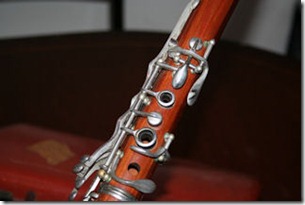I purchased this striking Pan American “Violin Finish” clarinet (made by Conn) that was mistakenly described on eBay as made from pear wood. It is more commonly known as the propeller wood clarinets. It was dirt cheap and at this point unplayable without an overhaul. Turns out this instrument was an ingenious solution by Conn to the scarcity of Granadilla wood during the Second World War. Unsubstantiated sources say the same wood was used in the manufacture of WWII B24 Liberator Bomber Propellers’, hence the nick name; “Propeller wood clarinet”. That has since be debunked. They came in plastic or Cocobolo plywood.
Bill Hausmann sez this about the instrument in the Klarinet Archive:
“I believe, Conn began manufacturing clarinets out of laminated wood (essentially thick plywood, similar to what is used to manufacture wooden aircraft propellers) to be sold under their cheaper Pan-American brand. The main idea was to create a clarinet which would not crack. When the laminated billets were turned on the lathes to produce clarinet bodies, a very beautiful false grain pattern was revealed. Since the laminated wood did not take stain well, the clarinets were left unstained and this, coupled with the very bold and symmetrical grain pattern, made these strikingly beautiful instruments.
While they do resist cracking very well, a bad batch of wood caused some of these clarinets to de-laminate, which ruined their reputation and production ended after just a few years. Officially called “violin finish,” these clarinets are not particularly good players, but are in high demand on eBay, etc., just for their looks.
I think the tone hole inserts were pretty much necessary on these models because the laminated wood would likely chip apart if they attempted to do the fine cutting necessary to make integral tone holes.”
My instrument is indeed a student quality instrument. The original mouthpiece was done in white acrylic.
The Pan American “Violin Finish” Clarinet according to the brochures, flyers and price lists was a light-colored violin finish for wood clarinets. They first popped up in the Spring of 1950 and the last mention of it was in January 18, 1954. The National Music Museum in South Dakota list these references for the clarinet model:
- Pan American “The Baton” Newsletter in Spring 1950 lists the “Violin Finish” Clarinet Model 68N for $120.00.
- It was listed as a new item in the C. G. Conn, Ltd. Annual Report to Stockholders for the year ending April 30, 1950.
- It was mentioned in the December 1951, June 8, 1953 and January 18, 1954 Conn price lists.














Hi,
Glad to fine you!
I have a red wood clarinet exactly like the one in the picture. I have the original case and mouth piece. It is recorked and repadded. It plays nice.
I would like to know what it is worth now.
Please respond,
Thank You,
Susie
There are so many factors that play into evaluating an instrument. How does it play, does it play? Are there hairline cracks in the instrument that you can’t see. The range is from $50 to $150. You might find someone to pay more for it, but that would most likely be an uninformed person.
Thank you for the good information. I have a clarinet (and case) that looks almost exactly like the ones shown in your picture. Clarinet has absolutely no markings except for what I take to be a serial number on the back of the upper body and the lower body (105351). Mine also has a “Charles Chedeville – Paris” black mouthpiece. Have you heard of any of these “laminated clarinets” that bear no manufacturer’s identification?
No, no I have not.
Sorry to burst anyone’s bubbles, but the B24 “Liberator” heavy bomber had four very substantial propellers made out of steel forgings, not wood. They were produced by Hamilton Standard, the go to firm for propellers during the period, and were licensed copies of a German design from the early 1930’s.
The only aircraft that the US (or anyone else, for that matter) may have fielded with wooden propellers during the period that the Conn clarinets were being made would have been some very small, primary trainer aircraft, and the propellors on those would not have been thick enough to serve as turning blanks for a clarinet.
Oddly enough, the one World War II era combat aircraft that was made largely of wood (the Japanese “Venus” suicide single seater, produced only in prototype form) had a propeller made of – you guessed it – steel forgings.
The reason that wooden propellers were abandoned shortly after World War I for all but the smallest of aircraft was that the engines of the period started producing much more in the way of power, and wooden props with their glued joints were failing under the strain. Early experiments were made with Bakelite plastic laminate propellers (which worked fine, but were subject to damage from flying objects (bullets and such), but the metal prop had crowded out all the rest by the end of the 1920’s or thereabouts.
Terry,
you forget the DeHavilland Mosquito?
I believe that the Mosquito had metal engine hangers and other critical parts (as well as a pair of handed or unhanded steel props). The Venus was one big lump of wood, save only (again) the prop and the landing gear struts.
There were several problems with the base Venus design, particularly with the engine mounts, and these (among others – pine root gasoline didn’t work very well in the old aircraft engines that were used to power the things) kept them from use during the war.
Wooden propellers were also made by the Japanese Musical Instrument Company, originated in the late 1800s by a man named Yamaha. During WW2, they made other assemblys for Japanese aircraft also. Later, after the war, they became the famous Yamaha Company. I own an
Eb full Boehm wooden clarinet from the 1910-1920 era made by the Japanese Musical Instrument Company. Check the internet for more history information on this company.
Sorry to return to topic, but how is it I am unable to see any ‘laminate’-like layers in the photos of this instrument. My take?… this is NOT a laminated, (and turned) structure; it’s just a different wood, unstained.
This is from David Mack Endres, dmendres@slb.com:
I called UMI (Conn) in Elkhart, and the person in customer service told me they had NO SERIAL NUMBER lists for Pan Americans. The Conn serial numbers on woodwind.org are not relevant to Pan American clarinets, so it is not vintage 1926. I was referred to the Shrine to Music Museum.
I contacted the museum, and was told the following: The instruments in question are actually “Violin Finish” clarinets manufactured for the Conn Pan American student line. Production started soon after WWII as Conn got it’s instrument lines running. They were manufactured from 1947 until 1949 or 1950. Records were destroyed so no serial number information is available. They are indeed a wood laminate. They would have probably been successful but a bad batch of wood was used and they got a reputation for cracking. As a consequence of this bad reputation the line eventually died. I find this striking because I had been informed by a instrument salesman familiar with the line that they had been guaranteed never to crack!
In summary, these “rosewood” look Pan American clarinets were a brief post war experiment in producing wood laminate clarinets with the durability of plastic (resonite) and an attractive finish. The experiment failed failed, possibly without good reason. I have heard various claims about their desirability as collector items, but the Museum could shed no light on this point.
Personally, I like mine, but not as well as my pre-R13 Buffet. The keywork and intonation are decidedly inferior. The tone is almost as good as the Buffet, though – without entering into mysticism, and without a spectrum analyzer I can say no more about the sound quality. I use it as a spare and when camping. And, I suppose one could claim I’m “collecting” it.
Pingback: The Clarinet Lady
Nice information on the Conn Prop! I Purchased two of them about 20 years ago, one from the USA (it has mended cracks) and another one from a fried in Hamburg (Germany), where I live. The second is really great, with a very loud tone and rather good intonation. Now I play it rarely, because I mainly blow on my “Oscar Adler” bass sax. Lutz